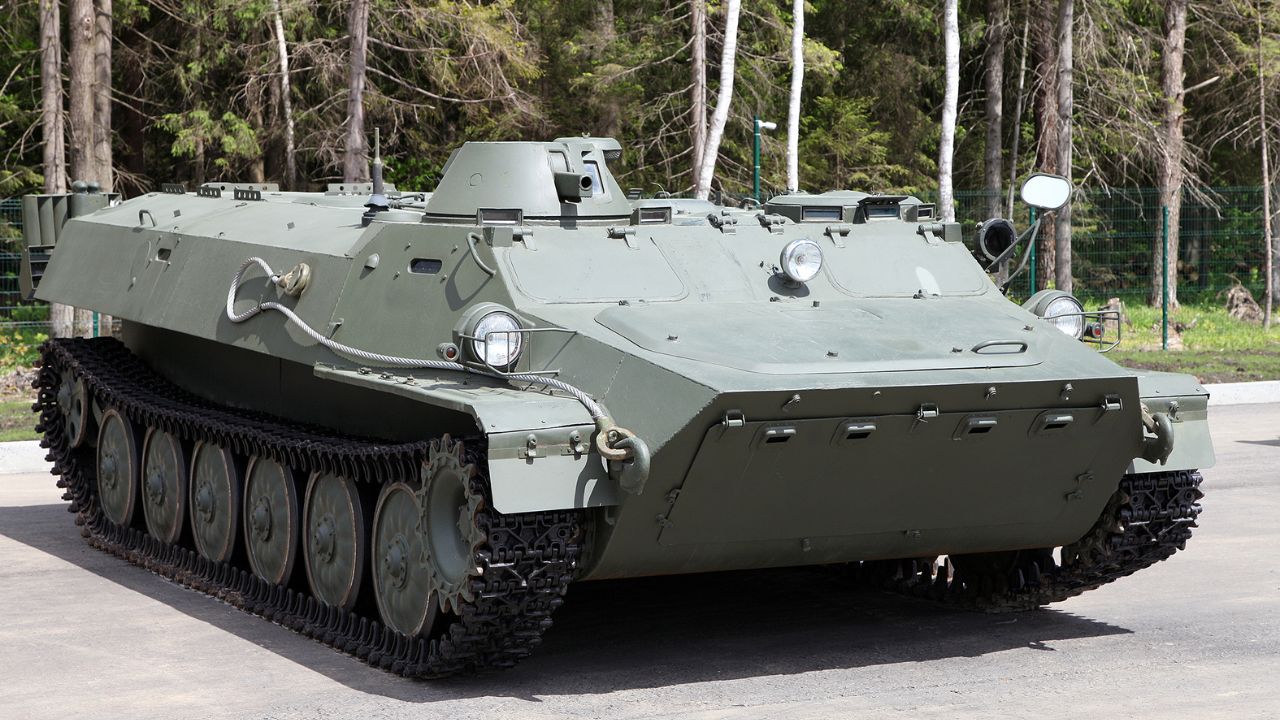Among all vehicles used by Russian and post-Soviet military forces, the MT-LB holds a unique reputation for being the most adaptable and widespread. Originally designed in the late 1960s as an artillery tractor, the vehicle’s reliability and modular design turned it into a platform for dozens of specialized military roles — from troop transport to mobile radar and even improvised fighting vehicles.
Defense analyst Dr. Viktor Churilov summarizes it aptly:
“The MT-LB is not glamorous, but it’s indispensable — the Swiss Army knife of the Russian military vehicle fleet.”
MT-LB Multipurpose Vehicle
The MT-LB (short for Mnogotselevoy Tyagach Lyogkiy Bronirovanny, or Multipurpose Towing Vehicle, Light Armored) is a fully amphibious, tracked vehicle primarily designed for mobility over snow, mud, and marshlands. Its design emphasizes simplicity, light weight, and modularity.
MT-LB Overview
| Specification | Details |
|---|---|
| Full Name | MT-LB (Multipurpose Light Armored Towing Vehicle) |
| Manufacturer | Kharkiv Tractor Plant (Ukraine, USSR era) |
| Year Introduced | 1969 |
| Weight | 9.7 tons |
| Crew + Passengers | 2 crew + 11 passengers |
| Engine | YaMZ-238V diesel, 240 hp |
| Max Speed | 61 km/h (road), 5–6 km/h (water) |
| Range | 500 km |
| Armor Thickness | 3–14 mm |
| Primary Armament | 7.62mm PKT machine gun (in turret) |
| Role | Multipurpose armored tractor and carrier |
Military historian Aleksandr Shevchenko comments:
“While tanks define offense, vehicles like the MT-LB define endurance. Without them, armies don’t move.”
Design Philosophy and Key Features
The MT-LB was never meant to dominate combat but to support and sustain it. It offered the Red Army a lightweight, tracked alternative that could tow heavy guns, carry ammunition, or transport soldiers under armor protection.
Key Features:
- Lightweight amphibious design for extreme terrains and river crossings.
- Exceptional fuel efficiency, extending operational range.
- Large interior compartment adaptable to numerous modifications.
- Simple mechanics allowing easy field repair and maintenance.
- Versatile chassis, used in more than 80 vehicle derivatives.
Defense engineer Irina Melnikova notes:
“What makes the MT-LB stand out is not its power, but its flexibility. It became a canvas for every possible battlefield role.”
Roles and Configurations
The MT-LB’s base chassis has supported an entire ecosystem of combat and support vehicles, such as:
- MT-LBu command vehicles
- Strela-10 SAM launchers
- SNAR-10 radar systems
- Mortar carriers and artillery tractors
- Ambulance and communication vehicles
This diversity has made the MT-LB one of the most ubiquitous tracked platforms in Russian and allied inventories.
MT-LB vs BMP-1 – Comparative Overview
| Feature | MT-LB | BMP-1 |
|---|---|---|
| Primary Role | Multipurpose transport/towing | Infantry Fighting Vehicle |
| Weight | 9.7 tons | 13 tons |
| Crew + Troops | 2 + 11 | 3 + 8 |
| Armament | 7.62mm MG | 73mm cannon + ATGM |
| Armor Protection | Light (up to 14mm) | Medium (up to 19mm) |
| Mobility | High (terrain-optimized) | Moderate |
| Amphibious | Yes | Yes |
| Operational Use | Logistics and support | Frontline infantry transport |
According to military vehicle expert Dr. Leonid Polyakov,
“The MT-LB’s success lies in its modesty. It doesn’t fight wars directly, but it makes victory possible.”
Recent Upgrades and Modern Adaptations
Since 2020, Russian defense industries have continued to modernize old MT-LBs, extending their lifespan:
- Armor reinforcements and modular add-ons.
- Remote weapon stations with 12.7mm or 14.5mm heavy machine guns.
- Thermal imaging optics for reconnaissance roles.
- Improvised adaptations, including anti-aircraft and artillery mounts.
In the ongoing modernization drive, MT-LB chassis are also used as low-cost combat support vehicles, especially in logistics-heavy operations.
Why the MT-LB Remains Relevant?
The MT-LB continues to serve because it fits perfectly in roles where cost, reliability, and adaptability matter more than armor thickness. With thousands still operational across former Soviet and allied nations, it remains an enduring military workhorse.
Analyst Major (Ret.) Sergei Ivanov notes:
“In a time when armies chase high-tech solutions, the MT-LB reminds us that reliability wins wars just as much as innovation.”
Why It Matters: Strategic and Logistical Value?
Despite its age, the MT-LB’s continued use reflects both necessity and brilliance in design. It can be upgraded cheaply, performs well in rugged terrain, and requires minimal maintenance — making it the logistical heartbeat of Russian mechanized forces.
FAQs
What does MT-LB stand for?
It means Multipurpose Light Armored Towing Vehicle in Russian.
How many MT-LBs are still in service?
Estimates suggest over 6,000 remain in use worldwide, especially in Russia and post-Soviet states.
Is the MT-LB still being produced?
Yes, modernized variants are still refurbished and produced for specialized roles.
Can the MT-LB operate in water?
Yes, it is fully amphibious, using its tracks for propulsion in water.
Why is it so common in Russian forces?
Because of its low cost, simplicity, and adaptability, it serves multiple support roles efficiently.
How does it compare to Western vehicles?
While Western APCs offer better protection, few match the MT-LB’s versatility and terrain mobility.
